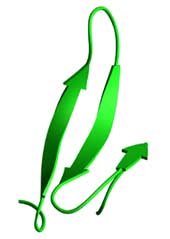 Structure
Structure
WW domains are compact 38 amino acid residue units that
fold into a three-stranded b-sheet structure.
A flat binding surface for the Pro-rich ligand is formed by conserved
hydrophobic residues. The domain name is derived from two conserved Trp
residues spaced 20 to 22 residues apart within the consensus sequence.
The figure shows the Pin1 WW domain.